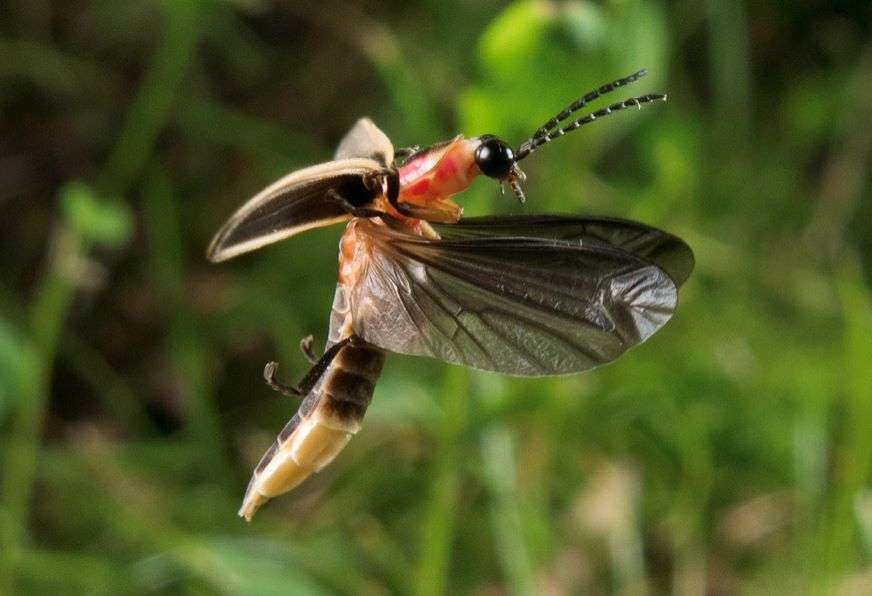Out in the Woods
- July 12th 2024
- Out in the Woods

The common eastern firefly, or big dipper
Photo: Terry Priest / Flickr Creative Commons 2.0
These Beetles Are Full of Bright Ideas
By Kevin McKeon, Maine Master Naturalist
Last summer was a wet one, and a lot of our underground creatures thrive in wet soils — especially firefly nymphs, as they forage through the damp soil feeding on the abundant slugs, worms, snails, and sometimes even other firefly nymphs. They’ll do this for two years, then overwinter as pupae (cocoon-like structures) under leaf litter, in shallow soil, in and under rotten logs, or between tree bark furrows. In early to late spring, the adults emerge after a complete metamorphosis into beetles. And since last winter was relatively mild, and spring was wet — optimal conditions for a pupa to survive — we’ve noticed more fireflies than usual. Also called lightning bugs and big dippers, the adults do not eat, living for only a few weeks during which time they must find a mate and reproduce.
Fireflies, like all beetles, have four life stages: egg, larva, pupa, and adult, with the majority of the life cycle spent in the larval stage. Firefly larvae are voracious predators as they hunt in their moist soil and marshy area habitats, using their jawbones to inject prey with paralyzing neurotoxins that immobilize. Then, they release digestive enzymes to cover and liquefy their dinner for easy eating.
Our fireflies came from the south, modern-day Texas, about 5 to 25 million years ago, migrating between various glacial periods to finally arrive at our damp fields and marshes. Adult lightning bugs rest in the daytime and become active around dusk or midnight, using their glowing and flashing to communicate with potential mates.
Lightning bugs don’t bite us, and don’t transfer any diseases; they are quite harmless. They’re sometimes called big dippers because of how they light up on an upswing of a J-shaped flight pattern, similar to a dipper. And it’s only the males that fly; the females remain on or close to the ground. They also flash light but look more like larvae, or grubs, and so are called glowworms.
Fireflies are found on every continent except Antarctica. More than 2,200 species have been described, with approximately 165 species documented in the United States and Canada. More species are being discovered and described each year. But fireflies are in trouble, and light pollution is a major culprit. Artificial lighting interferes with mating and can eliminate lightning bugs from an area. Lightning bugs, being slow flyers and flying only for localized mating, can’t relocate effectively to a friendlier habitat, so local populations tend to become extinct.
So where does the light that captivates us while gazing over our dark backyards and fields come from, and why?
Well, the “why” is that males use flashes to signal females, and the females signal back if receptive for mating. But to mate, survival is a must, so the flashing is also used for defense against predators. A steroid that some lightning bugs make is toxic, and predators attacking a firefly quickly learn that flashing lights are bad news. One unfortunate pet lizard was fed six fireflies and ended up in the pet cemetery!
Now for the “how” – fireflies create light, called bioluminescence, in their organs under their abdomens. It’s a cold light, as there is no heat produced — it’s essentially pure light. The enzyme luciferase reacts with the organic substance luciferin and other elements to generate light. Other creatures create light, too, like certain species of jellyfish, photo plankton, and algae. It wasn’t until 2018, through genome sequencing, that the gene responsible for the firefly’s production of luciferase was discovered. It has since been cloned and used in the molecular and biotechnological fields for various research, including cancer, cystic fibrosis, and cardiac disease.
NASA’s interest in firefly light began in 1963, eventually leading to a life-detection method. The 1975 Viking lander would scoop up a small amount of Martian soil, grind it up into dust, then add the firefly chemicals. If the soil glowed a certain way, it would be proof of the existence of living organisms on the planet – all from the wondrous lightning bug!






